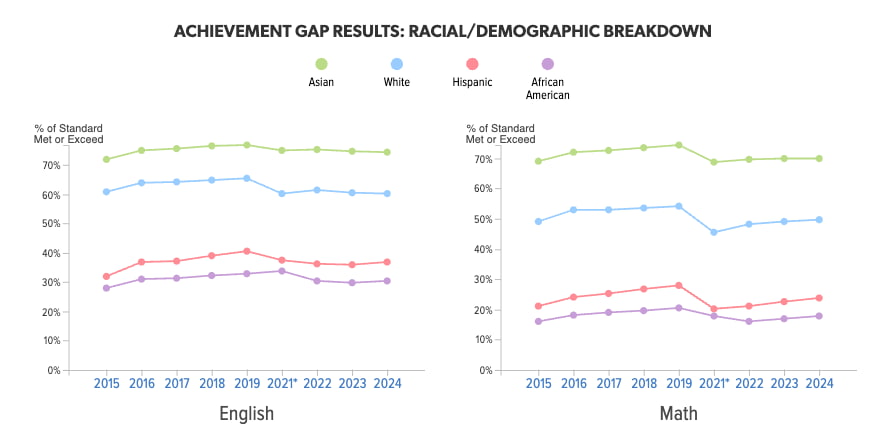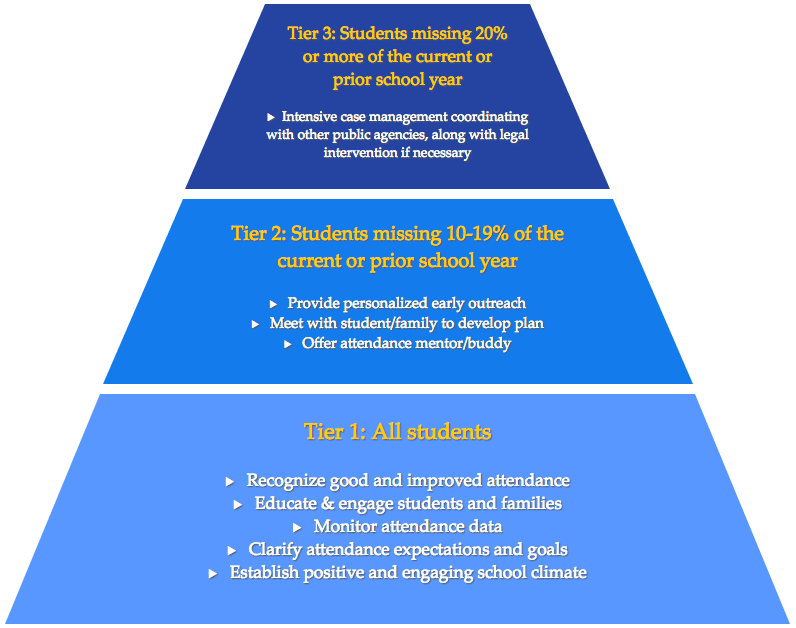
School attendance is mandatory for children in California beginning in first grade, but huge numbers of kids miss an awful lot of school. Chronic absenteeism is a corrosive problem in education, and the COVID-19 Pandemic made it a lot worse.
In This Lesson

Why is school attendance important?
What is chronic absenteeism?
What is truancy?
How is attendance different from enrollment?
Is attendance-based funding fair or unfair?
How does California count students?
What is attendance recovery?
What is an excused absence?
Are students counted absent if they are suspended?
What can schools do to improve attendance?
▶ Watch the video summary
★ Discussion Guide.
There’s a lot to know about school attendance, and this lesson breaks it down. Why is attendance important, and how do we know? How is attendance measured? What is chronic absenteeism? Why is attendance a bigger issue in California than in most other states? What can be done to improve it?
Why is school attendance important?
Let’s start with the obvious: when kids miss school, they fall behind. The resulting problems are cumulative — and contagious. It’s difficult for teachers to move a class of learners forward together under the best of circumstances. It’s extra hard to do so while also catching students up on lessons they missed.
The connections between learning and attendance have been exhaustively studied. AttendanceWorks, a non-profit organization focused on this issue, has collected mounds of evidence about it. Over time, kids who regularly miss class become more and more at risk of failure, which comes with huge costs.
Most kids don't drop out of school as a sudden, dramatic, rebellious choice. Something causes them to miss a day or two. Then maybe they show up less, then even less, and at a certain point the prospect of trying to catch up is too demoralizing.
When kids miss class, it’s serious. Alarm bells should go off.
What is chronic absenteeism?
20% of California students missed more than three weeks of school in 2023-24
Students are officially deemed chronically absent if they have missed 10% or more of instructional days since the beginning of the school term. The term is intended to be non-judgmental — there can be many reasons for kids to miss school, including prolonged illness. At the end of a 180-day school year, a student is deemed chronically absent if they missed at least 18 school days, the cumulative equivalent of more than three weeks of school.
To state the obvious, that’s a lot of missed school.
Even before the Pandemic, chronic absenteeism was a huge problem. In a typical pre-COVID year, about 750,000 California students (12%) were chronically absent. Let that sink in, because those were the good old days. In the Pandemic year of 2022, chronic absence rates skyrocketed to 30%. In 2024, the rate had fallen to 20% — a massive improvement, and better than most states, but still above the pre-pandemic baseline. The California Department of Education has established getting back to the pre-pandemic rate as a goal for 2030.
Kids fell behind in predictable patterns, which show up as achievement gaps.

Edsource.org visually summarizes state test scores over time with detail for student subgroups. Click the image above to find the data for your county, district, and school.
What is truancy?
Many absences fall under the broad meaning of truancy — missing school without a defensible reason. In California, students are officially truant if they miss more than 30 minutes of instruction on three days of school without an excuse. Families are supposed to receive a notification of some kind if a student misses enough school to meet this nip-it-in-the-bud threshold.
Many dislike the term truant because it implies that the student has done something wrong. As a practical matter, most kids rely on help from a parent or someone else to get to school. Because truancy is a warning signal for child neglect, it can serve as a basis for a referral to Child Protective Services.
Parents and legal guardians in California can be fined for failing to get their kids to school. When Vice President Kamala Harris was Attorney General of California, she spoke often about enforcing school attendance laws. As of this writing in Aug. 2025, a bill to repeal this provision is pending in the California Senate.
How does California count students differently from other states?
In all states, funding flows to school districts in some proportion to the number of students to be educated. But the particulars differ from place to place.
For the purpose of allocating funds, most states count students on the basis of enrollment — the number of students who are supposed to show up to school. California and a few other states count students on the basis of Average Daily Attendance (ADA), which includes only students who actually show up. It’s a very significant difference: In almost all school districts in California, if kids don’t come to school, the district doesn’t get money for them.
How is attendance counting different from enrollment?
Some argue that it is essential to fund schools on the basis of attendance, because doing so creates a financial incentive to get every kid to school every day. Because the incentive is massive, it makes financial sense for school districts to invest in technology, staff, programs and interventions that can boost attendance. Technology investments that help districts increase attendance can pay for themselves quickly — if they work. For example, effective attendance management systems enable school office staff to call parents if their students aren’t in school by a specific time.
Others argue that attendance-based funding is unfair. In wealthy communities it’s pretty easy to get kids to school consistently — should they be financially rewarded for it? If so, by how much? Should the incentive be 100%, as it is now, or something less, or zero? During the COVID-19 pandemic, school attendance counts became meaningless. With temporary federal support, California funded school districts with a system of bubble gum and chicken wire.
At the time of this writing (August 2025) calls to replace attendance-based funding seem to have died down, but the issue could easily return. In 2023 the state legislature seriously debated shifting to a membership-based model, like most states use. (Membership is basically jargon for enrollment.) It would be a big, disruptive change.
What is Attendance Recovery (AR)?
Starting with the 2025-2026 school year, California school districts and charter schools (LEAs) can recoup some of the ADA funding they lose from student absences by operating classroom-based Attendance Recovery (AR) programs after school, during weekends, or on intersession breaks. The amount of AR ADA that a district (LEA) may claim for a student is capped at the lesser of 10 days of attendance, or their number of absences in that fiscal year. Attendance advocates argue that the policy is a golden opportunity to help students catch up, if districts implement it strategically.
What is an excused absence?
California law defines specific reasons why a school district might consider a student absence excused. The reasons include attending a medical appointment, a funeral, or an educational conference for student leaders.
It’s important to understand that from a revenue perspective, there is no distinction between an excused absence and an unexcused one. When a district excuses an absence, it receives zero funding for doing so. In California, funds flow to districts on the basis of attendance, not attendance-plus-excused-absences.
Are students counted absent if they are suspended from school?
Yes. In an attendance-based school funding system like California’s, districts and charter schools receive funding only for students in attendance. When a school suspends a student from attending school, the district receives no daily attendance funding for that student. Schools, districts and county offices of education can formally encourage and enforce school attendance through organizations known as School Attendance Review Boards (SARBs).
The topic of school discipline is addressed in Ed100 Lesson 5.13, including alternatives to suspension, the meaning of willful defiance and more.
What can schools do to improve attendance?
Maybe your school already has the goal of ensuring that all kids attend school, every day. If so, bravo — but consider a slightly more personal framing: think of it as a goal for each student, each day.
The things that keep students from showing up at school can vary wildly. Often the issues are mundane and practical. Each student and each family has to solve for the things that get in the way. With focus, love and firmness, schools can help address those barriers. The challenge, of course, is the sheer volume of absences: how can schools address massive absenteeism effectively?
One thing is clear: When communicating about school attendance, schools are wise to choose their words with care. Keep the messages positive! Research demonstrates that small, cost-free changes in wording can make a big difference. Scolding parents doesn’t tend to work nearly as well as encouraging them.
The California Department of Education advises districts to “focus on transition grades (transitional kindergarten and kindergarten, sixth grade, and ninth grade), when chronic absence typically jumps.”
There is no shortage of materials to draw on and learn from. For example, FutureEd and Attendance Works jointly developed a useful Attendance Playbook that includes dozens of post-pandemic strategies to reduce chronic absences. Start with that report. When that's done, look at the many other strategies and materials for parents and school districts offered by Attendance Works.
The California office of the Attorney General, which also focuses on reducing absenteeism, recommends a three-tiered intervention strategy:

From creating a regular bedtime routine to making sure backpacks are ready to go in the morning, time-proven strategies really work, if parents know about them. The California Collaborative for Educational Excellence (CCEE) has curated a very useful collection of resources.
Equipped with all of these resources, PTAs can help parents learn about the importance of getting to class on time and not missing school. In 2023, the National PTA released a set of multicultural guides in English and Spanish to support local PTAs in this work.
This lesson concludes chapter 4 of Ed100, which examined the use and importance of time in education — the when of learning. Chapter 5 addresses the where of learning.
Updated September 2025.
CHAPTER 4:
Spending Time...
-
Spending Time...
Overview of Chapter 4 -
Preschool and Kindergarten
Yes, Early Childhood Education Matters -
Class Size
How Big Should Classes Be? -
School Hours
Is There Enough Time To Learn? -
Time Management in School
Spending Time Well -
Tutoring
When Kids Need More Time and Attention -
Summer School
Time to Learn, or Time to Forget? -
After School Learning
Extending the School Day -
Attendance
Don't Miss School!
Related
Sharing is caring!
Password Reset
Search all lesson and blog content here.
Login with Email
We will send your Login Link to your email
address. Click on the link and you will be
logged into Ed100. No more passwords to
remember!














Questions & Comments
To comment or reply, please sign in .
Carol Kocivar November 30, 2025 at 5:42 pm
Community school approaches significantly reduced chronic absence in the first year of implementation. CCSPP schools demonstrated a meaningful reduction in chronic absence; this reduction was, on average, 30% greater than that experienced by similar matched comparison schools. Improvements in regular attendance were most pronounced in elementary schools, suggesting particularly strong early implementation of attendance-focused strategies at this level. Because of the scale of the grant program, the average reduction in chronic absence rates equates to more than 5,000 additional students attending school regularly in the first year.
Learning Policy Institute
Jeff Camp - Founder November 23, 2025 at 9:25 am
Carol Kocivar September 22, 2025 at 11:39 am
-- From EdSource.
Carol Kocivar August 11, 2025 at 2:11 pm
Adding bus stops, serving biscuits and gravy, and catching butterflies: How schools are tackling absenteeism
https://hechingerreport.org/proof-points-schools-tackle-absenteeism/
Carol Kocivar December 28, 2024 at 4:48 pm
" The significant decline in school attendance since the onset of the pandemic is concerning since chronically absent students are more likely to fall behind academically, disengage socially, and drop out of school. As state policymakers consider solutions, much can be learned from community schools and other whole child approaches, which have emerged as research-based strategies to address barriers to attendance and help schools reengage students." Watch video recording. https://learningpolicyinstitute.org/event/webinar-eliminating-chronic-absence
Genee Woodson November 30, 2023 at 7:30 am
Roman Stearns November 27, 2023 at 4:30 pm
Carol Kocivar April 26, 2023 at 8:00 pm
from the Public Policy Institute of California
The state’s three largest nutrition programs—CalFresh, WIC, and school meals—serve almost 4 million California households. This fact sheet offers a snapshot of these programs and their impact on poverty.
https://www.ppic.org/publication/californias-nutrition-safety-net/?utm_source=ppic&utm_medium=email&utm_campaign=epub
Carol Kocivar April 26, 2023 at 7:00 pm
https://www.attendanceworks.org/new-report-how-do-unexcused-absences-disrupt-efforts-to-improve-attendance/
Carol Kocivar March 24, 2023 at 4:40 pm
Absenteeism and Truancy in California Schools: PACE March 2023
The report makes several recommendations, including using attendance data to identify disparities and bright spots; strengthening monitoring of reasons for absences; updating policies related to unexcused absences; improving communication of attendance policies to students and families; and investing in professional development to improve attendance practices.
https://edpolicyinca.us9.list-manage.com/track/click?u=dcb5c37ddafe5d3418812162d&id=5421e5b98d&e=d78a703d24
Carol Kocivar March 24, 2023 at 4:40 pm
Absenteeism and Truancy in California Schools: PACE March 2023
The report makes several recommendations, including using attendance data to identify disparities and bright spots; strengthening monitoring of reasons for absences; updating policies related to unexcused absences; improving communication of attendance policies to students and families; and investing in professional development to improve attendance practices.
https://edpolicyinca.us9.list-manage.com/track/click?u=dcb5c37ddafe5d3418812162d&id=5421e5b98d&e=d78a703d24
Carol Kocivar August 4, 2022 at 2:11 pm
The state 2022-23 Budget invests $2.8 billion ongoing and $413 million one-time Proposition 98 General Fund to cushion the financial blow of increased absences.
The Budget allows school districts to use the greater of current year or prior year average daily attendance or an average of the three prior years’ average daily attendance to calculate LCFF funding.
The Budget also enables all classroom-based local educational agencies that can demonstrate they provided independent study offerings in fiscal year 2021-22 to be funded at the greater of their current year average daily attendance or their current year enrollment adjusted for pre-COVID-19 absence rates in the 2021-22 fiscal year.
Carol Kocivar August 4, 2022 at 2:03 pm
The Budget allows school districts to use the greater of current year or prior year average daily attendance or an average of the three prior years’ average daily attendance to calculate LCFF funding.
The Budget enables all classroom-based local educational agencies that can demonstrate they provided independent study offerings to students in 2021-22 to be funded at the greater of their current year average daily attendance or their current year enrollment adjusted for pre-COVID-19 absence rates in the 2021-22 fiscal year.
Carol Kocivar June 14, 2022 at 12:50 pm
Three Major Drivers of LAO Projected Attendance Changes
• Longstanding declines in the school aged population. Project a reduction of 170,000 students by 2025-26.
• Recovery of pandemic-related declines. Assume increase equivalent to 140,000 students by 2025-26.
• Increased Transitional Kindergarten enrollment. Assume 230,000 additional students by 2025-26.
https://lao.ca.gov/handouts/education/2021/Attendance-Based-Funding-113021.pdf
Carol Kocivar June 14, 2022 at 12:40 pm
https://lao.ca.gov/reports/2022/4595/K-12-Student-Attendance-Update-051122.pdf
Carol Kocivar May 23, 2022 at 11:40 pm
https://fordhaminstitute.org/national/commentary/better-way-measure-student-absenteeism
Carol Kocivar May 15, 2022 at 3:11 pm
A Toolkit for Communicating with Students and Families This toolkit is designed to help educators and their community partners integrate attention to attendance and engagement into school daily operations. The goal is not to add more work to school staff who are stretched thin, but to enhance the effectiveness of what they already do. https://www.attendanceworks.org/resources/toolkits/showing-up-matters-for-real/
Jeff Camp - Founder April 13, 2022 at 7:03 am
Jeff Camp - Founder March 17, 2022 at 5:07 pm
Selisa Loeza October 23, 2021 at 10:39 pm
When I tested positive for COVID, my children missed 8 days of school to quarantine although I was isolated and they tested negative.
It makes complete sense from a health standpoint of keeping others safe, but it can still feel devastating to consider the impact.
Children are now also required to stay home if they have runny noses, etc because it could be a symptom.
We are now faced with health vs attendance and because of state requirements, not allowed to have access to online class time.
Benjamin Lemasters Tahir March 13, 2021 at 9:44 pm
Jamie Kiffel-Alcheh November 5, 2019 at 2:58 pm
Anoush Voskanian November 20, 2019 at 4:37 pm
Susannah Baxendale January 17, 2019 at 1:09 pm
Jeff Camp August 23, 2018 at 10:49 pm
Susannah Baxendale January 17, 2019 at 1:13 pm
nkbird August 9, 2018 at 5:10 pm
Carol Kocivar May 20, 2018 at 2:46 pm
Can a Few Simple Letters Home Reduce Chronic Absenteeism? New Research Shows They Can
Read it here here
Jeff Camp - Founder March 28, 2018 at 5:58 pm
Carol Kocivar December 6, 2017 at 11:39 am
Learn more in this article from EdSource:
https://edsource.org/2017/state-releases-data-on-chronic-absenteeism-to-help-flag-students-at-risk/591243?utm_source=newsletter&utm_medium=email
Carol Kocivar December 5, 2017 at 11:15 am
"As districts across the country try to drive down absenteeism, New York City leads the way'"
https://www.chalkbeat.org/posts/ny/2017/11/30/as-districts-across-the-country-try-to-drive-down-absenteeism-new-york-city-leads-the-way/
Carol Kocivar October 27, 2016 at 2:55 pm
Attendance: A Measure of School Success
Missing just two days of school in a month is a key warning sign for trouble. Yes, there are some things your school can do about it.
https://ed100.org/blog/Attendance-Success
Carol Kocivar October 27, 2016 at 2:48 pm
In School + On Track 2016
"An estimated 210,000 K-5 students in California are chronically absent – missing 10% of the school year – making up 7.3% of elementary school students in the state."
"Chronic absence rates are disproportionately high for certain groups of students and are concentrated in a small number of schools and districts:
• 77% of all chronically absent students are low-income
• The chronic absence rate for African American students (14%) is 2X the rate for all students
• 50% of chronically absent students in our sample attend 20% of schools and 10% of districts; 25% attend 7% of schools and 3% of districts."
"In 2013, just over half of districts surveyed said they tracked student attendance data over time. In 2016, 85% of districts reported that they do."
Find the report here: http://oag.ca.gov/truancy/2016.
Carol Kocivar June 10, 2016 at 4:14 pm
An inter-active web resource from the US Department of Education takes a close look at which groups of students are more likely to be chronically absent. The data is drawn from nearly every public school in the country and helps us understand who is chronically absent, at what grade levels chronic absenteeism tends to occur, and how chronic absenteeism compares community-by-community and state-by-state.
http://www2.ed.gov/datastory/chronicabsenteeism.html#intro
Jeff Camp - Founder February 5, 2016 at 1:31 pm
Santa Ana Unified School District (one of the CORE districts) has begun experimenting with ways to improve attendance, which is reported on the district's School Quality Improvement Index. (Yep, it's really called the "squee".) The district began operating a Saturday School for chronically absent students to make up for days missed. The curriculum for Saturday School is evolving: the point is to increase the chance that students at risk will decide that school is worth showing up for. Data in the SQII will help to evaluate the program's effectiveness.
Carol Kocivar December 5, 2015 at 11:24 am
The California Attorney General’s Office has created suggestions for school districts for inclusion in their LCAP's to address attendance and chronic absence issues.
https://oag.ca.gov/sites/all/files/agweb/pdfs/tr/ago_sample_lcap.pdf
Stacey W April 6, 2015 at 8:50 pm
Tara Massengill April 27, 2015 at 9:06 am
aimeef23 April 27, 2015 at 4:09 pm
JH McConnell October 19, 2015 at 11:25 pm
cnuptac March 22, 2015 at 6:44 pm
JH McConnell October 19, 2015 at 11:08 pm
Genee Woodson November 30, 2023 at 7:36 am
Rob M April 10, 2011 at 8:11 pm
Having the state create incentives for districts to focus energy on increasing attendance is important. At the same time, the state’s finance system will need to focus on more more than just seat time for schools to be able to take advantage of new learning opportunities such as distance learning or self-paced learning. In the end what we care about is how much students learn, not whether they have lots of seat time. This will be a difficult policy balance to retain the important focus on attendance while allowing districts to experiment with alternative methods of instruction.
JH McConnell October 19, 2015 at 11:18 pm
There is some truth, however, that students who are not going to school may resist going to school because they are not doing well there. In that case not going to school is an indicator of an existing problem, and not the cause of the problem. The cause of the problem may very well be inadequate or ineffective teachers or sub-standard instructional material.
Jeff Camp - Founder October 20, 2015 at 9:58 am
Lisette October 3, 2017 at 4:30 pm